Grizzly Bear Profile/ Grizzly Bear Facts Overview

GRIZZLY BEAR PHYSICAL DESCRIPTION
Grizzly weight and height
Most adult female grizzlies weigh 290–440 lbs. while adult males weigh 400–790 lbs on average. The average total length in this subspecies is 6.50 ft., with an average shoulder height of 3.35 ft. and hind foot length of 11 inches.
Newborn bears may weigh less than 1.1 lbs. In the Yukon River area, mature female grizzlies weigh as little as 220 lbs. On the other hand, an occasional huge male grizzly has been recorded, greatly exceeding standard size, with weights reported up to 1,500 lbs.
Although variable from blond to nearly black, grizzly bear fur is typically brown with white tips. A pronounced hump appears on their shoulders; the hump is an excellent way to distinguish a black bear from a grizzly bear, as black bears do not have this hump.
GRIZZLY BEAR GEOGRAPHICAL RANGE
Brown bears are found in Asia, Europe, and North America, giving them one of the widest ranges of bear species.
The ancestors of the grizzly bear originated in Eurasia and traveled to North America approximately 50,000 years ago. This is a very recent event in evolutionary time, causing the North American grizzly bear to be very similar to the brown bears inhabiting Europe and Asia.
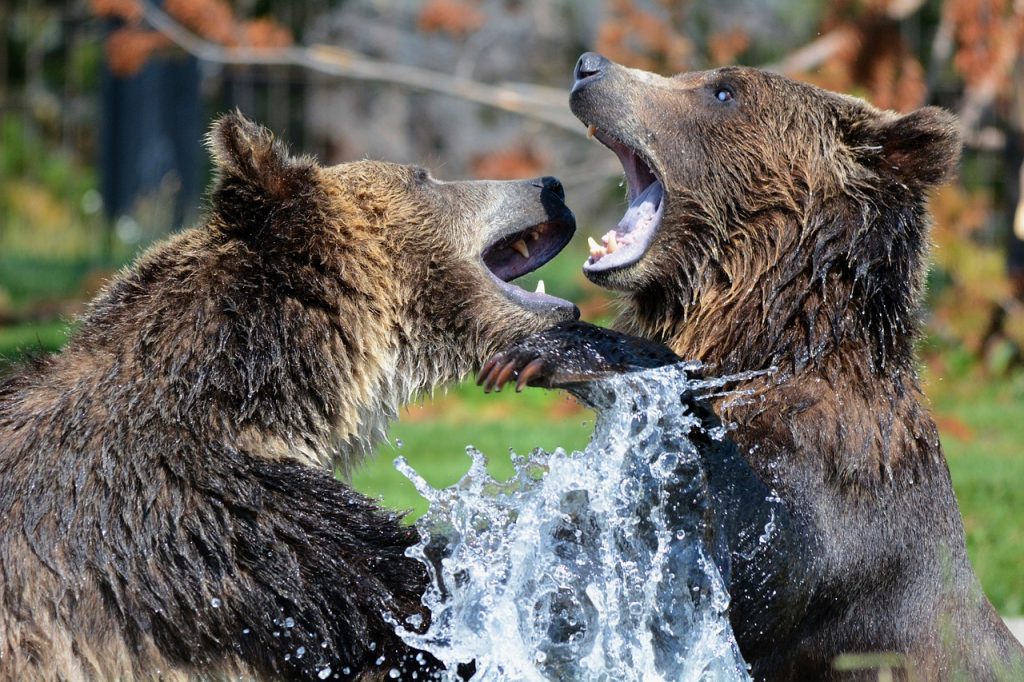
They need a lot of space
In North America, grizzly bears previously ranged from Alaska to Mexico and as far east as the western shores of Hudson Bay. In North America, the species is now found only in Alaska, south through much of western Canada, and into portions of the northwestern United States, including Idaho, Montana, Washington, and Wyoming, extending as far south as Yellowstone and Grand Teton National Parks, but is most commonly found in Canada.
In September 2007, a hunter produced evidence of grizzly bears returning to the Selway-Bitterroot Wilderness ecosystem, in Idaho and western Montana, by killing a male grizzly bear. Its original range also included much of the Great Plains and the southwestern states, but it has been extirpated in most of those areas.
The grizzly bear appears on the flag of California, though they are extinct in the state, the last one being shot in 1922.
Some experts consider grizzlies to be more aggressive than black bears when defending themselves and their offspring. Numerous selection variables favor aggressive behavior in grizzly bears.
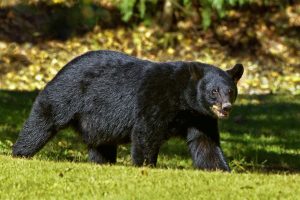
Grizzlies and black bears
Unlike the smaller black bears, adult grizzlies are too large to escape danger by climbing trees, so they respond to danger by standing their ground and warding off their attackers. Increased aggressiveness also assists female grizzlies in better ensuring the survival of their young to reproductive age. Mothers defending their cubs are the most prone to attacking,responsible for 70% of fatal human injuries. Historically, bears have competed with other large predators for food, which also favors increased aggression. Campers are warned to hang food, garbage, and toiletries out of reach of bears or to use a secure bear cache.
They are more dangerous to humans than sharks
Grizzly bears typically avoid contact with people. Despite their obvious physical advantages and many opportunities, they rarely view humans as prey; bears seldom actively hunt humans. Most grizzly bear attacks result from a bear that has been surprised at very close range, especially if it has a supply of food to protect or female grizzlies protecting their offspring. In such situations, property may be damaged, and the bear may physically harm the person.
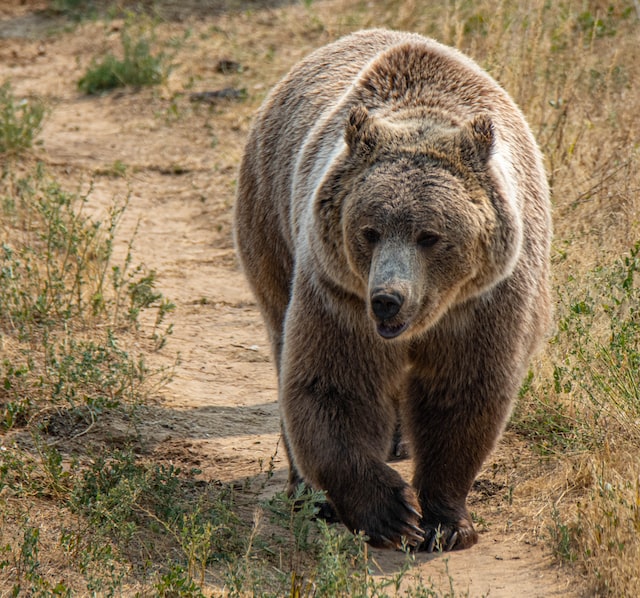
Grizzlies’ claws are as long as human fingers
Exacerbating this is the fact that intensive human use of grizzly habitat coincides with the seasonal movement of grizzly bears. An example of this spatiotemporal intersection occurs during the fall season: grizzly bears congregate near streams to feed on salmon while anglers also intensively use the river.
Some grizzly bears appear to have learned to hone in on the sound of hunters’ gunshots in late fall as a source of potential food, and inattentive hunters have been attacked by bears trying to appropriate their kills.
Increased human–bear interaction has created “problem bears,” which are bears that have become adapted to human activities or habitats. Aversive conditioning, a method involving using deterrents such as rubber bullets, foul-tasting chemicals, or acoustic devices to teach bears to associate humans with negative experiences, is ineffectual when bears have already learned to associate humans positively with food. Such bears are trans-located or killed because they pose a threat to humans. The B.C. government kills approximately 50 problem bears each year and overall spends more than one million dollars annually to address bear complaints, relocate bears, and kill them.
For back-country campers, hanging food between trees at a height unreachable to bears is a standard procedure, although some grizzlies can climb and reach hanging food in other ways. An alternative to hanging food is to use a bear canister.
Traveling in groups of six or more can significantly reduce the chance of bear-related injuries while hiking in bear country.
For a complete description and scientific view of these creatures, go to: http://en.wikipedia.org/wiki/Grizzly_bears
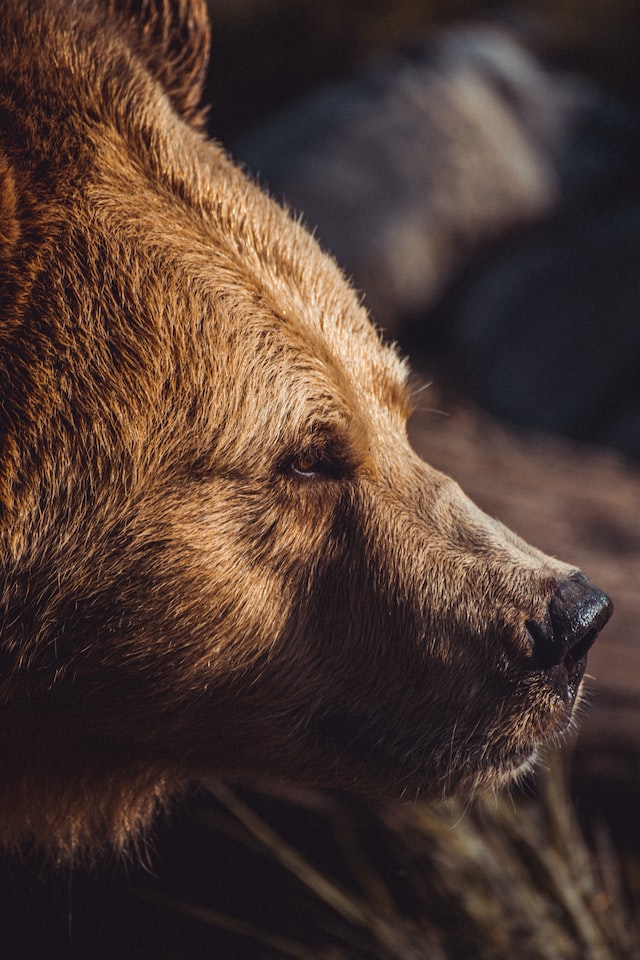
They are called “grizzly” both for their fur and their nature
Grizzly bears are known for their distinct fur coloration, which can appear grayish or “grizzled” due to the presence of light-tipped hairs among the darker ones. They also have a reputation for being formidable and territorial animals who tend to exhibit aggression toward humans if provoked or threatened. The name “grizzly” is believed to have originated from the word “grisly,” meaning “horrible” or “terrifying,” and has come to be associated with both the bear’s appearance and its intimidating behavior.
Brown bears /They are a subspecies of the brown bear
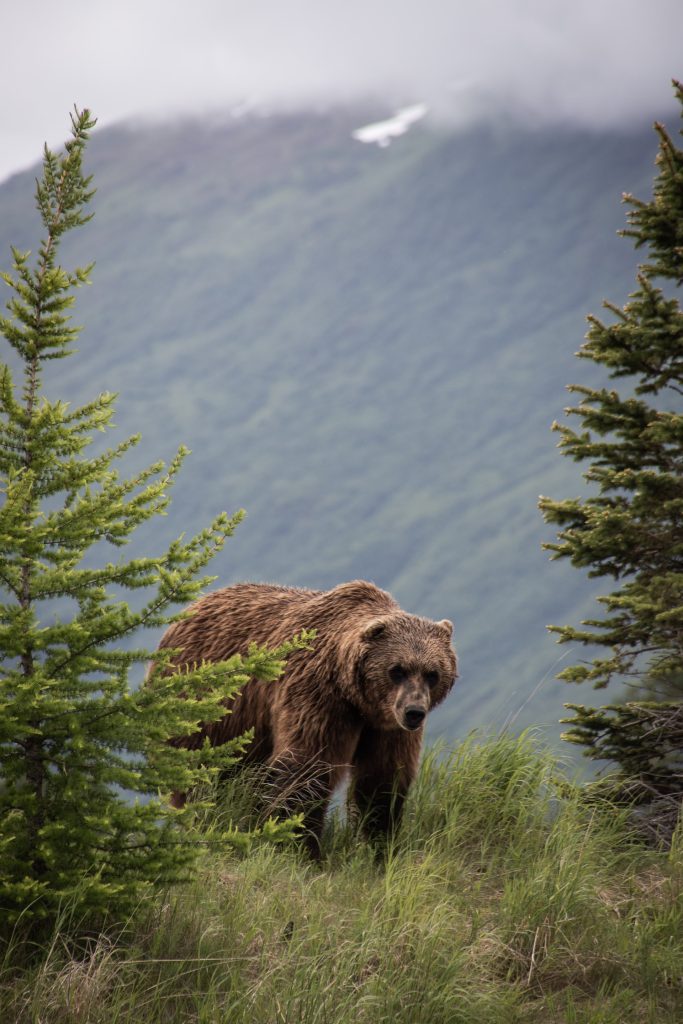
Subspecies in North America
Grizzly bears are a particular subspecies of brown bears. They are typically found in remote and mountainous regions of North America. They have shorter and more concave facial features, smaller sizes, and a distinct fur coloration that ranges from blonde to dark brown or black. Brown bears are much larger and can weigh up to 1,400 pounds with a shoulder height of up to 9 feet. They are found across North America and Eurasia and can inhabit a variety of environments, such as forests, tundra, and grasslands.
Both subspecies have an omnivorous diet and territorial behavior, but there are some differences in their habitats and adaptations. Grizzlies are adapted to colder environments by developing a muscle hump on their shoulders that allows them to conserve heat and dig for food. In contrast, brown bears are found in different habitats and can consume a broader range of food sources.
Grizzly and brown bears play important roles in their respective ecosystems as apex predators. Still, both are under threat from habitat loss and hunting. It is, therefore critical to protect these magnificent species through conservation efforts for future generations to appreciate and enjoy.
They are apex predators
Grizzly bears are classified as apex predators because in their ecosystem, they are at the top of the food chain. They have no natural predators and play a crucial role in regulating the populations of other species, including elk, moose, rodents, and insects.
Grizzly bears are very opportunistic eaters
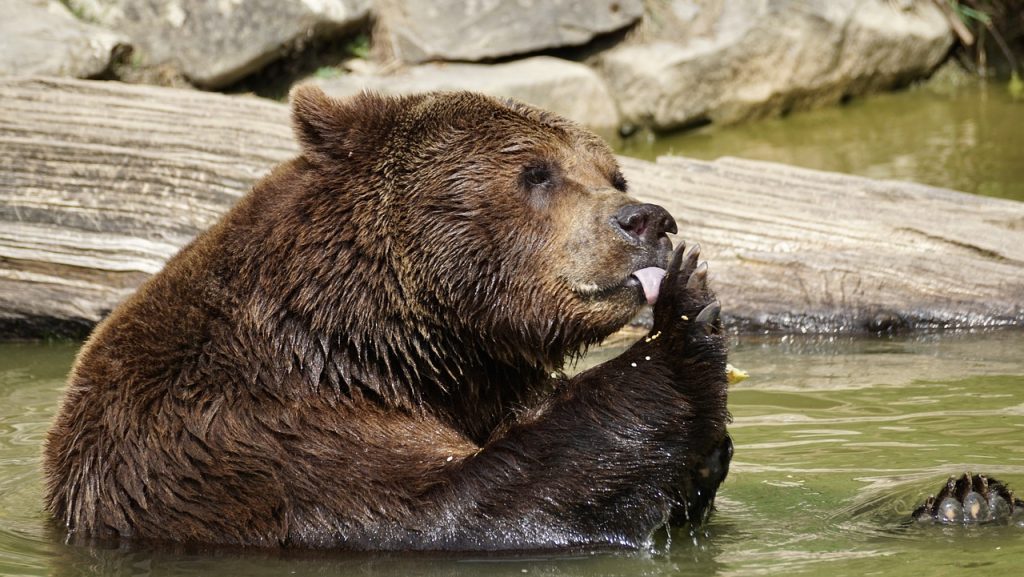
As omnivores, grizzlies have a varied diet consisting of plant matter and meat. They acquire food through hunting, scavenging, and foraging. Their sharp claws, powerful build, and strong sense of smell make them effective predators capable of taking down larger prey such as bison and caribou. They can also catch fish and hunt smaller animals like rodents and insects.
Grizzly bears also impact their environment in other ways besides feeding. For example, their scat can distribute plant seeds, and their foraging behavior can create open spaces in forests, which promotes new growth and plant diversity. Their presence in an ecosystem can also influence the behavior of other species, including those lower down in the food chain.
Overall, grizzly bears are apex predators because of their significant impact on their ecosystem and the absence of natural predators to regulate their populations. They are a vital part of their ecosystem, and it is essential to maintain healthy and balanced wildlife populations.

Mama bears are fierce
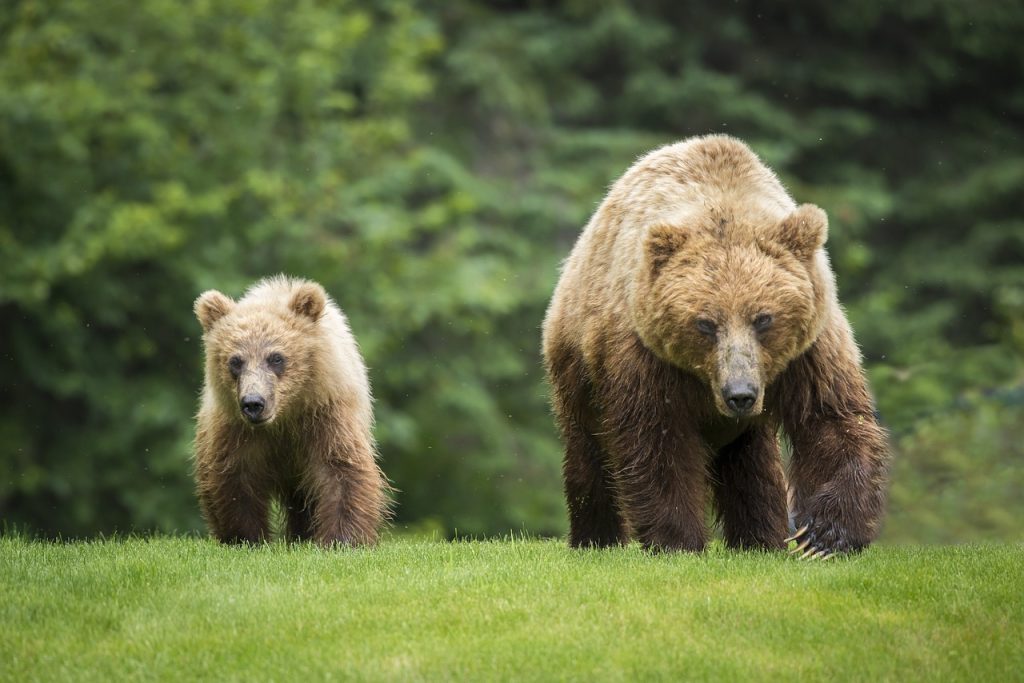
Grizzly bears are known for their protective nature when it comes to their cubs, and their parenting strategies are fascinating to observe.
Grizzly bear cubs are typically born in the winter while their mother is hibernating. The cubs are blind, hairless, and weigh only about a pound. The mother bear will nurse her cubs for the first months of their lives until they’re old enough to start eating solid food.
As the cubs grow, the mother bear will teach them how to find food, including plants, berries, and small animals. Grizzly bears are omnivores, meaning they eat both plants and animals. Still, their diet can vary depending on the season and availability of food.
The mother bear will protect her cubs from predators and other potential dangers. She will teach her cubs how to swim, and climb trees and help them develop their hunting skills. Grizzly bear cubs usually stay with their mother for about two to three years until they are old enough to fend for themselves.
During this time, the mother bear will gradually teach her cubs how to become independent while still providing them with protection and guidance. She will also establish a hierarchy amongst her cubs, with the strongest and most competent cub becoming the future leader. Once the cubs are fully independent, they leave their mother and venture off independently.
They hibernate for 5-7 months every year
Grizzly bears have a remarkable ability to hibernate, which helps them to conserve energy and survive during the winter months when food is scarce. Hibernation is a state of dormancy where the bear’s body temperature, heart rate, and breathing slow down, allowing them to use less energy and reduce its metabolic rate.

They eat a lot of food before they hibernate
Grizzly bears typically begin hibernation in the fall, around October or November, and can remain in this state for up to six months. Before hibernation, the bears will consume a large amount of food, including berries, nuts, and fish, to build up fat reserves, sustaining them through the winter.
During hibernation, grizzly bears will remain in their dens, often dug out of the ground or located in hollowed-out trees or rock crevices. The dens provide insulation and protection from the cold weather, and the bear will curl up and conserve heat by wrapping their body tightly with their paws.
Despite being in a state of hibernation, grizzly bears can still be aroused if they sense danger or if their body temperature drops too low. When this happens, their heart rate and breathing will increase, and they will become alert to their surroundings.
When the weather begins to warm in the spring, grizzly bears will emerge from their dens and start looking for food. They may be weak and groggy initially but will gradually regain their strength and start hunting and foraging for food.
In conclusion, hibernation is a vital survival strategy for grizzly bears. By slowing their metabolic rate and conserving energy, they can survive through the winter months when food is scarce. Despite being dormant, grizzly bears can still respond to danger and changes in their environment, allowing them to remain vigilant and protect themselves and their young.
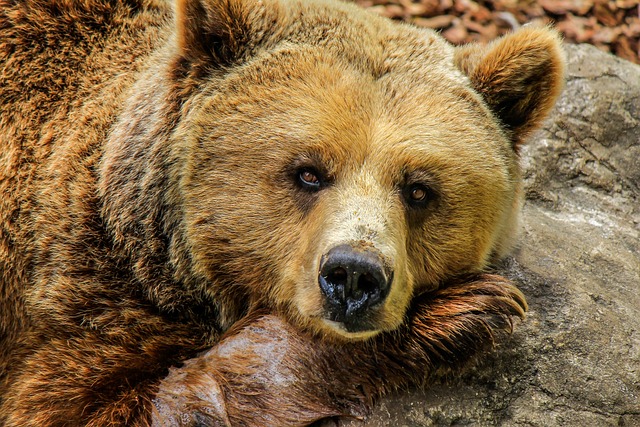
Grizzlies and wolves are competitors
Grizzly bears and wolves are two of the most iconic and dominant predators that inhabit the same ecosystems in the wild. Although they compete for resources, their relationship is much more nuanced and complex.
Wolves and grizzly bears both have a wide hunting range and feed on similar prey, including large herbivores such as deer, elk, and moose. Consequently, competition for food can arise, leading to conflicts between the two species. However, grizzly bears are less likely to confront wolves directly, as they are more agile and hunt in packs, which gives them an advantage over larger predators.
Grizzlies and various small predators
Grizzly bears also have to compete with smaller predators like foxes and coyotes for small prey such as rodents and birds. Nevertheless, there have been cases where wolves and grizzly bears have shared resources, such as scavenging from each other’s kills. In some situations, wolves’ hunting activities can even create more prey availability for grizzly bears.

Conservation efforts
However, human activities like hunting and habitat destruction have put both grizzly bears and wolves at risk, as their existence heavily relies on maintaining healthy ecosystems. As a result, conservation efforts have been aimed at preserving their natural habitats and reducing human interference, which is necessary to protect both species’ future survival.
In conclusion, grizzly bears and wolves share a complex relationship where they compete for resources but can also benefit from each other’s presence. Nevertheless, it is important to ensure they are both protected and conserved to maintain the ecological balance in their habitats.

